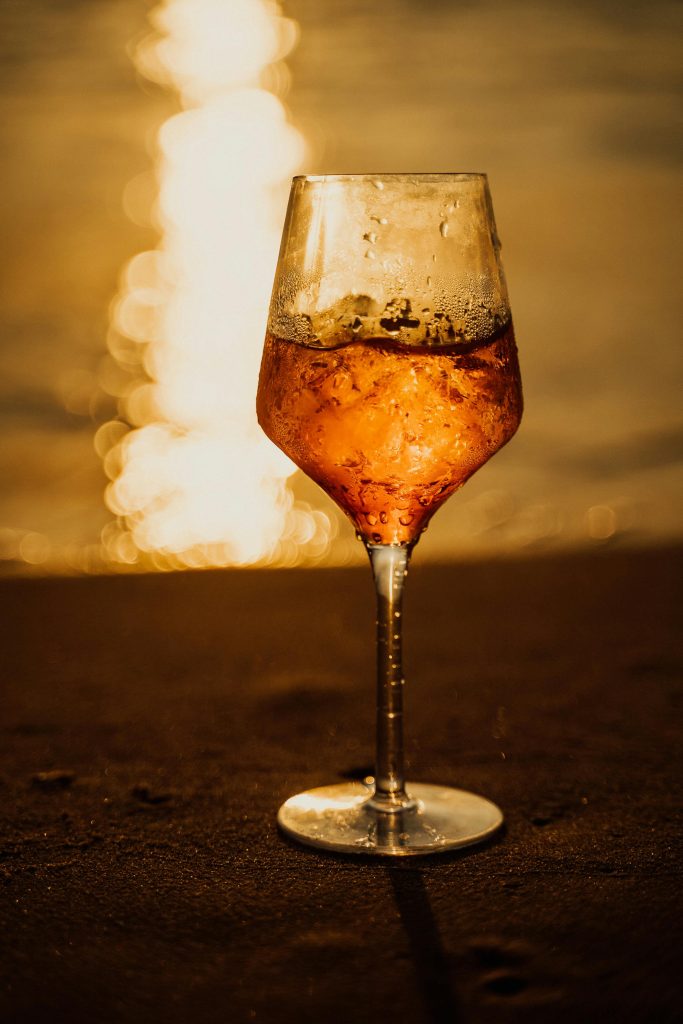
Have you ever strolled down the wine aisle and paused in front of a bottle labeled “orange wine”? Maybe you even wondered, “Is this wine made with oranges?” You’re not alone. That question pops into the mind of many curious wine lovers.
So, What Exactly Is Orange Wine?
The first thing you should know is that orange wine isn’t made from oranges at all. I know—it sounds crazy! The name might make you imagine a tangy, citrus-filled drink. But the truth is much more interesting. Orange wine is made from white grapes. The secret lies in the winemaking process, which differs from how we typically make white wines.
A Quick History Lesson
Wine has been around for thousands of years, and winemaking techniques have evolved over time. Long ago, winemakers used a method that involved leaving the grape skins in contact with the juice. This wasn’t unusual back then. Today, most white wines skip this step to maintain a light, crisp flavor. However, some winemakers have revived the old technique to create something unique: orange wine.
This revival has sparked a bit of a renaissance in the wine world. Many modern winemakers enjoy experimenting with age-old methods to produce wines that stand out. Orange wine is a testament to that creativity.

How Is Orange Wine Made?
The process of making orange wine might sound a bit complex, but it’s actually quite straightforward. Here’s a breakdown of what happens:
- White Grapes: Winemakers start with white grapes. No oranges in the mix!
- Extended Skin Contact: Instead of removing the grape skins right away, winemakers let them soak with the juice. This is the key step.
- Fermentation: The mixture ferments slowly. During fermentation, the skins release tannins and other compounds.
- Unique Flavors: This extra contact gives the wine a distinct flavor, texture, and color. It may even take on a slightly orange hue—hence the name!
This technique resembles the process used for making red wine. In red wine production, grape skins stay in contact with the juice for a long time. For orange wine, the skin contact happens with white grapes, which gives the wine an unusual twist.
The Benefits of Extended Skin Contact
Why do winemakers choose this method? Here are a few reasons:
- Flavor Complexity: Extended skin contact adds layers of flavor. The wine might have hints of spice, dried fruit, or even herbal notes.
- Texture: The tannins from the skins provide a bit of structure. This makes the wine more robust.
- Color: The wine often gets a rich, amber-orange hue. It’s as appealing to the eyes as it is to the palate.
- Tradition Meets Innovation: It blends ancient methods with modern techniques, offering something both classic and contemporary.
If you’re curious to learn more about this style of wine, check out this detailed resource on orange wine.

How Does Orange Wine Compare to Other Wines?
You might be wondering how orange wine stacks up against the wines you already love. Let’s break it down with a simple table that compares white wine, red wine, and orange wine:
| Feature | White Wine | Red Wine | Orange Wine |
|---|---|---|---|
| Base Fruit | White grapes | Red or black grapes | White grapes |
| Skin Contact | Minimal | Extended | Extended |
| Color | Pale yellow/light gold | Deep red/purple | Amber/orange hue |
| Flavor Profile | Crisp, fruity, floral | Bold, tannic, rich | Complex, earthy, slightly tannic |
| Tannins | Low | High | Moderate |
| Aging Potential | Usually best young | Often benefits from aging | Can age well due to tannins |
This table shows that orange wine occupies a unique space. It borrows techniques from red winemaking while using white grapes. The result is a wine with an entirely distinct personality.
What Does Orange Wine Taste Like?
Imagine taking a sip of something that surprises you. With orange wine, you get a mix of flavors that might not be what you expect from a white wine. Here’s what you might notice:
- A Bit of Spice: Many orange wines have subtle spicy notes. They can remind you of dried herbs or even a touch of citrus zest.
- Earthy Undertones: The skin contact can bring out earthy flavors. These might remind you of fresh soil or autumn leaves.
- Fruity Elements: Despite the extra tannins, you’ll still get fruity flavors. Think of dried apricots, peaches, or even a hint of apple.
- Complex and Bold: The extended skin contact creates layers of complexity. With each sip, you might discover something new.
Many wine enthusiasts love orange wine for these unexpected twists. It offers a departure from the norm and challenges your palate in delightful ways.
Pairing Orange Wine with Food
Pairing wine with food can sometimes feel like solving a fun puzzle. Orange wine pairs well with many different dishes. Here are some ideas to get you started:
- Spicy Dishes: The wine’s tannins and spice can handle a bit of heat. Try it with spicy Thai or Indian cuisine.
- Rich, Creamy Cheeses: The wine’s acidity cuts through creaminess. Give it a shot with aged cheddar or gouda.
- Roasted Meats: Its robust flavors can stand up to roasted chicken or pork.
- Vegetarian Fare: The earthy notes work well with hearty vegetable dishes, like roasted root vegetables or a vibrant grain salad.
For a quick recap, here’s a bullet list of food pairings:
- Spicy Asian dishes
- Rich, creamy cheeses
- Roasted or grilled meats
- Savory vegetarian meals
If you’re looking to explore more unique wines and pairings, check out The Little Cellar Wine Company. They offer a range of interesting wines that might just spark your next culinary adventure.
The Rise in Popularity of Orange Wine
Over the past few years, orange wine has experienced a surge in popularity. This rise can be attributed to several factors:
- Curiosity: Wine lovers always seek something new. Orange wine delivers an exciting twist on tradition.
- Artisan Craftsmanship: Many winemakers today focus on traditional, artisanal methods. They craft wines with a personal touch, which appeals to a modern audience.
- Foodie Culture: The foodie movement has embraced unique pairings. Orange wine’s complexity fits right in with innovative dishes.
- Sustainability: Some winemakers who produce orange wine focus on organic and biodynamic practices. This sustainable approach attracts eco-conscious consumers.
These trends have turned orange wine into a favorite among both casual sippers and serious connoisseurs.

Debunking Myths About Orange Wine
When a wine has such an intriguing name, myths tend to emerge. Let’s clear up a few common misconceptions:
- Myth: Orange Wine Is Made with Oranges.
Truth: As we mentioned earlier, orange wine comes from white grapes. The name refers to the wine’s color, not its ingredients. - Myth: It Tastes Like Citrus.
Truth: Despite its name, orange wine doesn’t taste like the fruit. Its flavor profile is more complex and may include hints of spice, dried fruit, and earthiness. - Myth: It’s Only for Wine Aficionados.
Truth: Anyone can enjoy orange wine. It offers a refreshing alternative to traditional wines and invites new experiences. - Myth: It’s a New Trend.
Truth: While its modern popularity has surged, the technique behind orange wine is ancient. Winemakers have been using extended skin contact for centuries.
By debunking these myths, we can all appreciate orange wine for what it really is: a beautiful blend of tradition and innovation.
Exploring the Possibility: Can We Make Wine Out of Oranges?
Now, let’s have some fun and explore an interesting twist. What if we actually made wine out of oranges? Yes, you read that right—using real oranges! It might seem like a playful idea, but it also opens up a discussion about fruit wines in general.
The Basics of Fruit Wine
Fruit wines aren’t a new concept. People have been fermenting a variety of fruits for centuries. In many parts of the world, local fruits like berries, apples, and even peaches get turned into wine. So why not oranges? Oranges have a bright, refreshing flavor that could make a delicious wine.
How Would You Make Orange Wine from Oranges?
Here’s a basic overview of how you might create a wine from oranges:
- Selecting the Fruit:
Choose ripe, high-quality oranges. Organic oranges work best if you can get them. - Preparation:
- Peel or No Peel? Some recipes suggest using the whole fruit, while others recommend peeling to reduce bitterness. Experimentation might be the key here!
- Juicing: Squeeze out the juice. Some methods involve leaving in some pulp or zest for extra flavor.
- Fermentation Process:
- Yeast Addition: Just like grape wine, you’d add wine yeast. The yeast converts the sugars in the orange juice into alcohol.
- Sugar Content: Oranges have natural sugars, but you may need to adjust the sugar levels to achieve the desired alcohol content.
- Temperature and Time: Maintain a steady fermentation temperature. Fermentation times can vary from a few weeks to several months.
- Aging and Clarification:
- After fermentation, you would let the wine age. This step allows the flavors to meld together.
- Clarification methods (like fining and filtering) help remove any solids, leaving you with a smoother final product.
Pros and Cons of Making Wine from Oranges
It’s fun to consider the advantages and potential challenges. Let’s break it down:
- Pros:
- Unique Flavor: The citrusy burst from oranges could create a refreshing, tangy wine.
- Aromatic Qualities: Orange wine (made from oranges) might have vibrant aromas reminiscent of a sunny orchard.
- Creative Exploration: It offers winemakers and home enthusiasts a chance to experiment outside the traditional grape boundaries.
- Cons:
- Acidity Issues: Oranges are naturally acidic. Balancing that acidity with the right sweetness and alcohol level can be tricky.
- Pectin and Cloudiness: Oranges contain pectin, which may lead to a hazy wine unless properly managed.
- Flavor Balance: Getting the right flavor balance is key. Too much bitterness from the peel or pith could overwhelm the wine.
A Quick Comparison: Traditional Orange Wine vs. Orange Wine from Oranges
Let’s look at a table that compares traditional orange wine (from white grapes with extended skin contact) and a hypothetical wine made directly from oranges:
| Feature | Traditional Orange Wine | Orange Wine from Oranges |
|---|---|---|
| Base Ingredient | White grapes | Oranges |
| Fermentation Process | Extended skin contact with grape skins | Standard fruit wine fermentation |
| Flavor Profile | Complex, earthy, slightly tannic | Citrusy, bright, potentially tangy |
| Color | Amber/orange hue from grape skins | Likely vibrant orange, dependent on peel usage |
| Tannin Level | Moderate due to grape skins | Low; may need adjustments for body |
| Challenges | Balancing tannins and acidity | Managing high acidity and pectin haze |
As you can see, each has its own character. Traditional orange wine gives you that bold, earthy twist, while a wine made from oranges would likely be fresher and more citrus-forward.
Real-World Examples
Believe it or not, there are some examples of citrus-based wines out there. Some winemakers have experimented with lemon, lime, and other citrus fruits. These wines are often enjoyed as dessert wines or as a refreshing beverage on a hot day. Though not as common as grape-based wines, they showcase the versatility of fruit fermentation.
Pairing and Enjoying Orange Wine—Either Way!
No matter which type of wine you choose, pairing them with food can be a delightful adventure. Whether you’re sipping traditional orange wine or exploring a homemade one from actual oranges, here are some pairing ideas:
- Spicy Cuisine: The natural acidity and zestiness of an orange-based wine can cut through spicy dishes like Thai or Indian curries.
- Citrus-Infused Salads: Enhance a salad with citrus segments, avocado, and a light vinaigrette to complement the wine’s bright notes.
- Seafood: Both wines can pair wonderfully with grilled or seared fish, as the citrus elements help highlight the freshness of the seafood.
- Cheese: Try pairing with tangy goat cheese or a sharp cheddar. The acidity in the wine can balance the creaminess and richness of the cheese.
The Future of Orange-Inspired Wines
The wine world is always evolving, and there’s room for innovation. While traditional orange wine (from white grapes) continues to gain traction, the idea of making wine directly from oranges might catch on with creative winemakers and adventurous home brewers.
Some trends we might see include:
- Innovative Fermentation Techniques: Experimentation with different yeasts and fermentation methods could lead to new styles of citrus wines.
- Sustainability: As sustainable and organic practices become more popular, using locally sourced fruits like oranges could become part of a green winemaking movement.
- Flavor Fusion: Expect exciting flavor combinations, perhaps blending traditional grapes with a splash of citrus for a unique twist.
Wrapping It All Up
In the end, orange wine proves that a name can be deceiving. Traditional orange wine isn’t made with oranges—it’s all about white grapes and a time-honored method of extended skin contact. This process gives the wine its distinctive color, bold flavor, and rich texture.
But what if we took it a step further? Making wine out of actual oranges isn’t as far-fetched as it might sound. While it comes with its own set of challenges, it also offers a fresh, innovative approach to fruit wine. Both methods celebrate creativity and tradition in their own right.
We’ve talked about the origins, how these wines are made, their unique flavor profiles, and even how to pair them with your favorite dishes. I hope our chat has cleared up any confusion about orange wine and sparked your interest in exploring new tastes.
Next time you’re out shopping or browsing online, consider reaching for a bottle of orange wine. If you’d like to explore more interesting wine facts, be sure to visit The Little Cellar Wine Company.
Wine is a journey. Every bottle tells a story of tradition, experimentation, and passion. Whether you stick with the classic method or get adventurous with real oranges, the world of wine always has something new to offer.